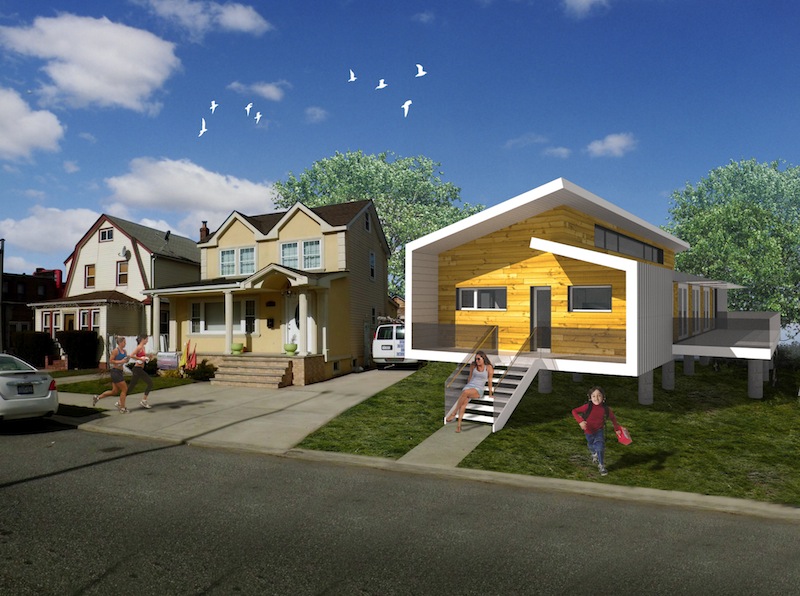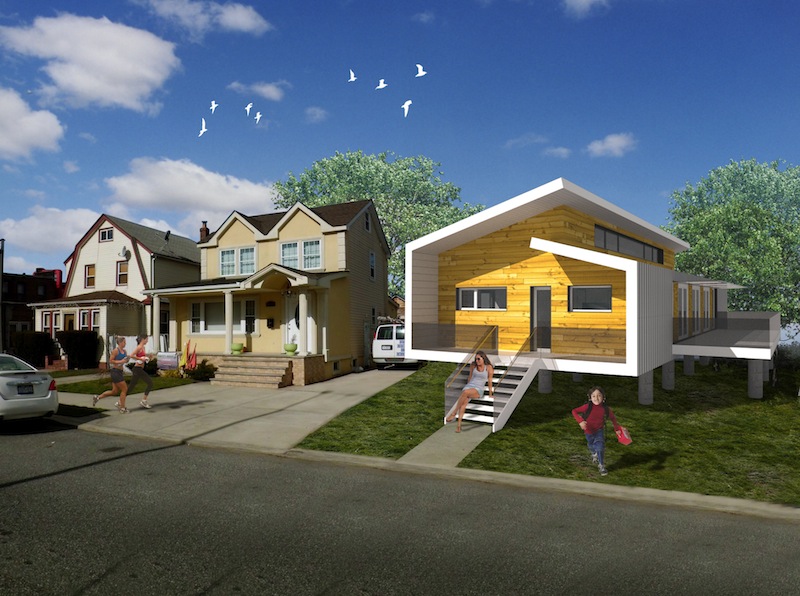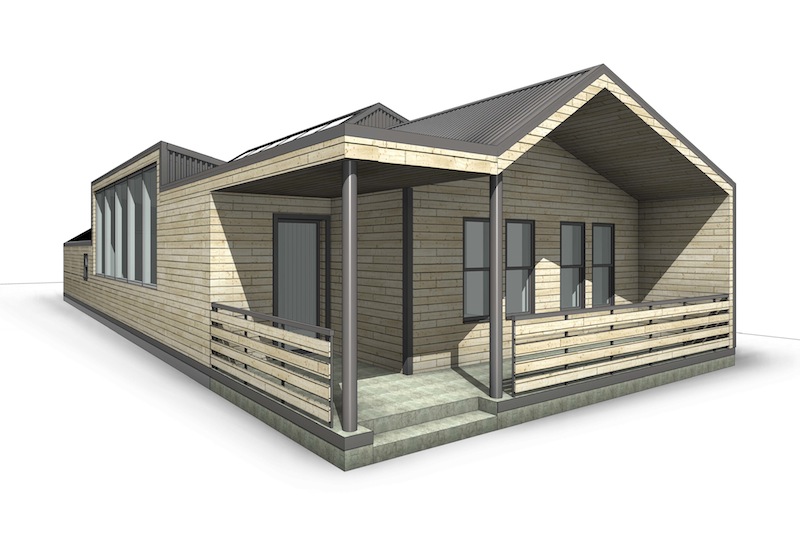The American Institute of Architects, in partnership with Make It Right, St. Bernard Project, Architecture for Humanity and Dow Building Solutions recently concluded “Designing Recovery,” an ideas competition created to aid in the rebuilding of sustainable and resilient communities. The competition was designed to help survivors of recent natural disasters in three distinct settings: New York City, New Orleans, and Joplin, Mo.
“When examining all of the designs submitted we continually asked ourselves if this would be a house we would want to live in regardless of safety considerations,” said Jury Chair, Michael Willis, FAIA, NOMA. “The three designs that we chose all had the ideal combination of addressing disaster mitigation and actual livability. The designs all had the sort of flexibility to be both a resilient safe haven during a natural disaster, but also serve as a dwelling that catered to family conditions and would blend into appropriate neighborhood styles without projecting a ‘bunker-like’ feeling.”
Although there could be just three winning designs, all of the entries that are feasible to construct will go into production in the corresponding communities and include:
1. Shotgun Remix
Designed by GOATstudio LLP, the Shotgun [remix] proposal for New Orleans offers a fresh, contemporary take on a familiar local typology. Modern touches like sliding polycarbonate privacy panels, vaulted interior spaces, clean, modern detailing, an open floor plan, and a steel roof that turns and wraps the southern exterior wall for additional sun protection update the historical shotgun form to better accommodate modern lifestyles and increased environmental challenges.
To help manage the threat from rising sea levels and increasing yearly rainfall, the finish floor will be elevated 7 feet above the ground plane and filter storm runoff through a perimeter rain garden, alleviating on-site ponding and reducing the load on strained city infrastructure. By employing similar construction methodologies and materials as those that have been thoroughly vetted by Make It Right since 2007, the design will be able to achieve LEED Platinum status and provide 6.25 kWh of solar energy to the owners.
2. Resilient House
Designed by Sustainable.TO Architecture + Building, the Resilient House for New York has a layout that orients living spaces towards the sun, and minimizes interior partitions. Structurally insulated panels allow for a tightly sealed and highly insulated building enclosure. Combined with a highly efficient ventilation system and upgraded windows, these design elements project to a 30% reduction in annual energy consumption. The house will be built above the floodplain with a flood-proof foundation to ensure natural disasters will not affect the structure. By using traditional construction methods and equipment, this dwelling can be built for less than $50,000 in material cost.
3. CORE House
Designed by Q4 Architects, CORE House in Joplin, MO is designed to address the local vernacular by combining two single-cell homes: a centrally located "Safe House" acts as the hearth and divides a "Perimeter House." The Safe House contains all of the functions of ‘home’ that are necessary for a family to recover quickly from disaster and live for an extended period of time until rebuilding is possible.
The walls of the Safe House are constructed of filled and anchored carbon-neutral concrete masonry units. Rainwater is collected, stored, and filtered for reuse. Locally sourced building materials were consciously considered so that CORE will have little impact on the progression of climate change, reduce the effects of debris in a natural disaster, and elevate local economies.
About The American Institute of Architects
Founded in 1857, members of the American Institute of Architects consistently work to create more valuable, healthy, secure, and sustainable buildings, neighborhoods, and communities. Through nearly 300 state and local chapters, the AIA advocates for public policies that promote economic vitality and public well-being. Members adhere to a code of ethics and conduct to ensure the highest professional standards. The AIA provides members with tools and resources to assist them in their careers and business as well as engaging civic and government leaders, and the public to find solutions to pressing issues facing our communities, institutions, nation and world. Visit www.aia.org.
About Architecture for Humanity
Architecture for Humanity is a nonprofit design services firm founded in 1999. By building a more sustainable future through the power of professional design, Architecture for Humanity taps a network of more than 75,000 professionals willing to lend time and expertise to help those who would not otherwise be able to afford their services. They bring design, construction and development services where they are most critically needed. For more information, please visit architectureforhumanity.org
St. Bernard Project
St. Bernard Project (SBP) is an award-winning rebuilding, nonprofit organization whose mission is to ensure that disaster-impacted citizens and communities recover in a prompt, efficient and predictable manner. Through its Disaster Recovery Lab, SBP works to share lessons learned, prevent common barriers to recovery, and help communities utilize SBP’s standardized, repeatable and proven-effective model. Since its founding in 2006, SBP has rebuilt homes for over 600 families in greater New Orleans, Louisiana and Joplin, Missouri with the help of 50,000 volunteers. In the wake of Hurricane Sandy, SBP is working on the ground in Rockaway and Staten Island, New York to help displaced families rebuild their homes and rebuild their lives. For more information, visit stbernardproject.org and sandy.stbernardproject.org.
Make It Right
Founded by Brad Pitt, Make It Right builds healthy, Cradle to Cradle-inspired homes, buildings and communities for people in need. Make It Right is currently working in New Orleans, LA, Newark, NJ, Kansas City, MO and the Fort Peck Reservation, MT. Learn more at www.makeitright.org.
Dow Building Solutions
Dow Building Solutions has a 60+ year legacy of providing energy saving solutions to the construction industry, which began with the launch of STYROFOAM™ Brand Extruded Polystyrene Foam Insulation. A business unit of The Dow Chemical Company, Dow Building Solutions offers insulation, air sealing and weatherization solutions to improve the performance of homes and buildings and reduce energy costs while contributing to the reduction of greenhouse gas emissions. Visit www.dowbuildingsolutions.com.
Related Stories
Office Buildings | Mar 27, 2024
A new Singapore office campus inaugurates the Jurong Innovation District, a business park located in a tropical rainforest
Surbana Jurong, an urban, infrastructure and managed services consulting firm, recently opened its new headquarters in Singapore. Surbana Jurong Campus inaugurates the Jurong Innovation District, a business park set in a tropical rainforest.
Cultural Facilities | Mar 27, 2024
Kansas City’s new Sobela Ocean Aquarium home to nearly 8,000 animals in 34 habitats
Kansas City’s new Sobela Ocean Aquarium is a world-class facility home to nearly 8,000 animals in 34 habitats ranging from small tanks to a giant 400,000-gallon shark tank.
Cultural Facilities | Mar 26, 2024
Renovation restores century-old Brooklyn Paramount Theater to its original use
The renovation of the iconic Brooklyn Paramount Theater restored the building to its original purpose as a movie theater and music performance venue. Long Island University had acquired the venue in the 1960s and repurposed it as the school’s basketball court.
Green | Mar 25, 2024
Zero-carbon multifamily development designed for transactive energy
Living EmPower House, which is set to be the first zero-carbon, replicable, and equitable multifamily development designed for transactive energy, recently was awarded a $9 million Next EPIC Grant Construction Loan from the State of California.
Museums | Mar 25, 2024
Chrysler Museum of Art’s newly expanded Perry Glass Studio will display the art of glassmaking
In Norfolk, Va., the Chrysler Museum of Art’s Perry Glass Studio, an educational facility for glassmaking, will open a new addition in May. That will be followed by a renovation of the existing building scheduled for completion in December.
Sustainability | Mar 21, 2024
World’s first TRUE-certified building project completed in California
GENESIS Marina, an expansive laboratory and office campus in Brisbane, Calif., is the world’s first Total Resource Use and Efficiency (TRUE)-certified construction endeavor. The certification recognizes projects that achieve outstanding levels of resource efficiency through waste reduction, reuse, and recycling practices.
Office Buildings | Mar 21, 2024
Corporate carbon reduction pledges will have big impact on office market
Corporate carbon reduction commitments will have a significant impact on office leasing over the next few years. Businesses that have pledged to reduce their organization’s impact on climate change must ensure their next lease allows them to show material progress on their goals, according to a report by JLL.
Adaptive Reuse | Mar 21, 2024
Massachusetts launches program to spur office-to-residential conversions statewide
Massachusetts Gov. Maura Healey recently launched a program to help cities across the state identify underused office buildings that are best suited for residential conversions.
Legislation | Mar 21, 2024
Bill would mandate solar panels on public buildings in New York City
A recently introduced bill in the New York City Council would mandate solar panel installations on the roofs of all city-owned buildings. The legislation would require 100 MW of solar photovoltaic systems be installed on public buildings by the end of 2025.




















